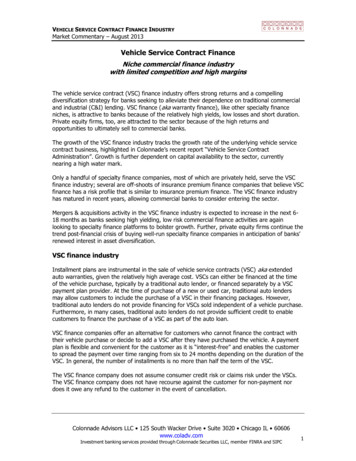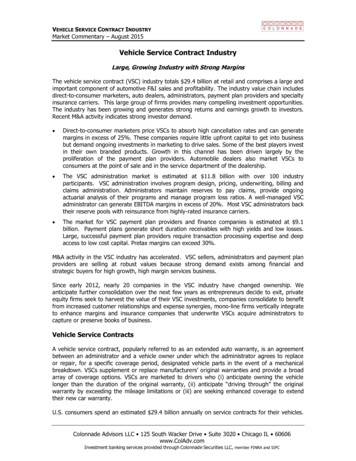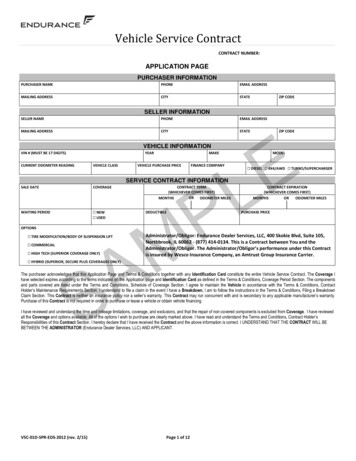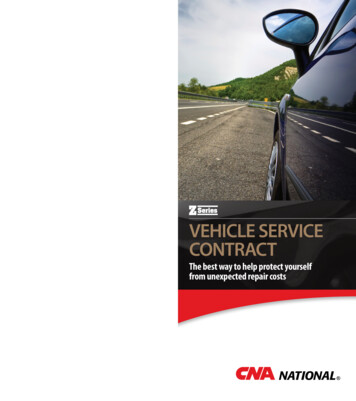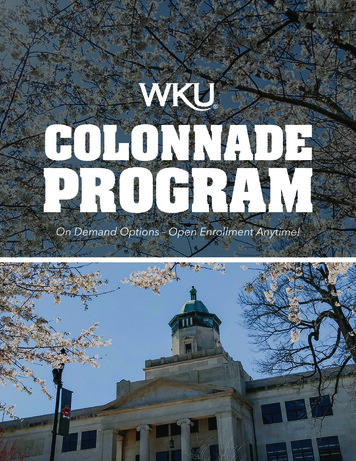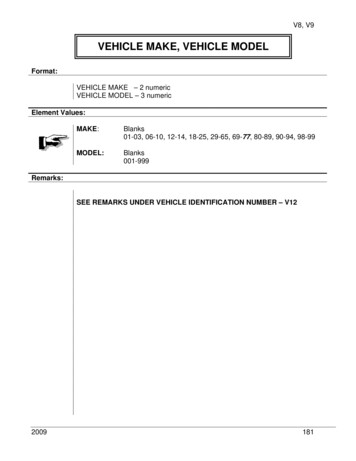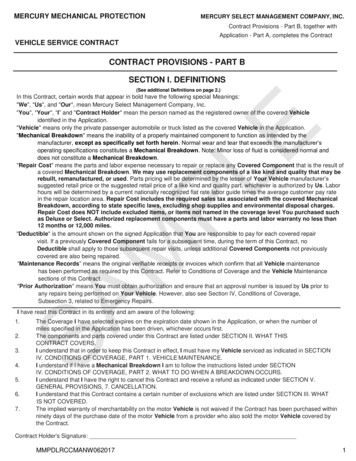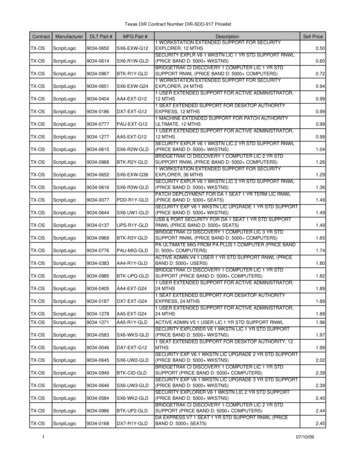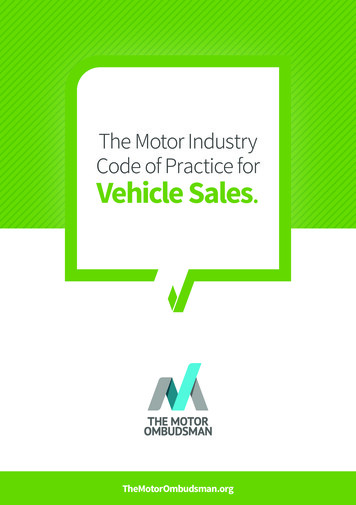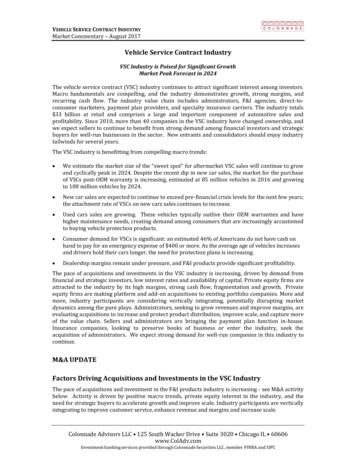
Transcription
VEHICLE SERVICE CONTRACT INDUSTRYMarket Commentary – August 2017Vehicle Service Contract IndustryVSC Industry is Poised for Significant GrowthMarket Peak Forecast in 2024The vehicle service contract (VSC) industry continues to attract significant interest among investors.Macro fundamentals are compelling, and the industry demonstrates growth, strong margins, andrecurring cash flow. The industry value chain includes administrators, F&I agencies, direct-toconsumer marketers, payment plan providers, and specialty insurance carriers. The industry totals 33 billion at retail and comprises a large and important component of automotive sales andprofitability. Since 2010, more than 40 companies in the VSC industry have changed ownership, andwe expect sellers to continue to benefit from strong demand among financial investors and strategicbuyers for well-run businesses in the sector. New entrants and consolidators should enjoy industrytailwinds for several years.The VSC industry is benefitting from compelling macro trends: We estimate the market size of the “sweet spot” for aftermarket VSC sales will continue to growand cyclically peak in 2024. Despite the recent dip in new car sales, the market for the purchaseof VSCs post-OEM warranty is increasing, estimated at 85 million vehicles in 2016 and growingto 108 million vehicles by 2024. New car sales are expected to continue to exceed pre-financial crisis levels for the next few years;the attachment rate of VSCs on new cars sales continues to increase. Used cars sales are growing. These vehicles typically outlive their OEM warranties and havehigher maintenance needs, creating demand among consumers that are increasingly accustomedto buying vehicle protection products. Consumer demand for VSCs is significant: an estimated 46% of Americans do not have cash onhand to pay for an emergency expense of 400 or more. As the average age of vehicles increasesand drivers hold their cars longer, the need for protection plans is increasing. Dealership margins remain under pressure, and F&I products provide significant profitability.The pace of acquisitions and investments in the VSC industry is increasing, driven by demand fromfinancial and strategic investors, low interest rates and availability of capital. Private equity firms areattracted to the industry by its high margins, strong cash flow, fragmentation and growth. Privateequity firms are making platform and add-on acquisitions to existing portfolio companies. More andmore, industry participants are considering vertically integrating, potentially disrupting marketdynamics among the pure plays. Administrators, seeking to grow revenues and improve margins, areevaluating acquisitions to increase and protect product distribution, improve scale, and capture moreof the value chain. Sellers and administrators are bringing the payment plan function in-house.Insurance companies, looking to preserve books of business or enter the industry, seek theacquisition of administrators. We expect strong demand for well-run companies in this industry tocontinue.M&A UPDATEFactors Driving Acquisitions and Investments in the VSC IndustryThe pace of acquisitions and investment in the F&I products industry is increasing - see M&A activitybelow. Activity is driven by positive macro trends, private equity interest in the industry, and theneed for strategic buyers to accelerate growth and improve scale. Industry participants are verticallyintegrating to improve customer service, enhance revenue and margins and increase scale.Colonnade Advisors LLC 125 South Wacker Drive Suite 3020 Chicago IL 60606www.ColAdv.comInvestment banking services provided through Colonnade Securities LLC, member FINRA and SIPC
VEHICLE SERVICE CONTRACT INDUSTRYMarket Commentary – August 2017Business Model DifferentiationThere are multiple segments in the VSC industry and companies use varied business models. Thereare pure play companies in each of the industry segments and others that integrate multiplesegments, as demonstrated in the graphic below.Direct-to-Consumer MarketersThere are at least 90 direct-to-consumer marketing companies in the U.S. focused on the VSCindustry. These companies use three primary origination channels: direct mail, Internet andtelevision/radio. Colonnade estimates 300 million pieces of mail per year are sent by these firms. Thedirect-to-consumer marketers are often marketing on an unbranded basis, but a few haveestablished their own brands, such as Protect My Car, Endurance and CarShield. This approachrequires significant monetary investment and time. Direct-to-consumer marketers experiencecancellation rates in the 40%-60% range, including cancels during the first month post-sale.Dealerships, which usually finance the sale of a VSC by adding it to the vehicle loan, typicallyexperience a cancellation rate of 5%-10%. Direct-to-consumer marketers price the cancellation riskinto the VSC. As the direct-to-consumer marketing companies have higher expense levels associatedwith marketing costs and cancellations compared to the dealership sales, their contracts aregenerally priced higher, and they typically have the highest margins in the industry.As the VSC industry has matured, administrators, payment plan providers and insurers have becomemore selective in choosing direct marketing partners. Direct-to-consumer marketers distinguishColonnade Advisors LLC 125 South Wacker Drive Suite 3020 Chicago IL 60606www.ColAdv.comInvestment banking services provided through Colonnade Securities LLC, member FINRA and SIPC
VEHICLE SERVICE CONTRACT INDUSTRYMarket Commentary – August 2017themselves through high Better Business Bureau ratings, employee compliance certification (fromthe Academy of Certified Vehicle Protect Professionals or the Vehicle Protection Association), andpositive ratings on consumer websites, such as Consumer Affairs.AdministratorsThe administrator universe is fragmented with over 100 operators. The largest non-OEMadministrator has approximately 5% of the total market, and we estimate that the top fiveadministrators have 20% of the market. Administrators are selling their products to the endconsumer through dealerships or through direct-to-consumer marketers. To reach the dealerships,administrators utilize a direct sales force and/or independent F&I agents. With an independent F&Iagent sales force, the administrator's reach is broader, however F&I agents are not exclusive, and theadministator can sometimes struggle for agent mindshare. The direct sales force receives salary pluscommission, whereas the independent F&I agents are compensated via a mark-up to the VSC uponsale at the dealership. Administrators also resell their products through direct-to-consumermarketers, which typically offer their customers the products of multiple administrators.Administrators are differentiated by the dealerships they address: franchise versus independents.The franchise dealerships have greater F&I sophistication. The competition among administrators toestablish a relationship with franchisees is high, resulting in long sales cycles and weak relationships.The independent dealerships typically sell older used cars with higher mileage, necessitating adifferent set of VSC features.Independent administrators sometimes compete with OEMs for VSC sales on new cars in franchisedealerships. Non-OEM administrators will bundle VSCs with other F&I products, such as tire andwheel, to distinguish their products from the OEM VSCs.Payment Plan ProvidersPayment plan providers generate high yielding, short term receivables when a buyer of a VSC(outside of the auto loan) elects to pay in installments. Since most VSC’s sold by auto dealers arefinanced as part of the vehicle loan, the payment plan segment generates most of its receivables fromdirect sellers of VSCs that market to consumers that already own a vehicle. Pursuant to a contractualagreement, a VSC finance company purchases at a discount the right to receive the payment stream;discounts typically range from 5%-15%. The finance company funds a portion to the administratorand a commission payment to the seller. Customers who elect to pay in installments agree to make adown payment (typically 10%) and a series of fixed monthly payments for a period of time generallyranging from six to 24 months, depending on the term of the VSC.There are a handful of independent firms specializing in VSC payment plans. In April, the two largestindependents, PayLink and Omnisure, merged, creating a company with a significant share of thedirect-to-consumer market. In May, Seabury Asset Management acquired Mepco, creating a wellcapitalized, rapidly growing company. While the DTC market is still growing, payment plancompanies are challenged to make inroads in the dealer markets, which represent the long termgrowth opportunity. Service Payment Plan and Budco Financial have longstanding dealer and OEMrelationships. New entrants, such as Line 5, offer longer payment terms that match the term of theF&I product through a loan product.Increasingly, DTC marketers and administrators are financing their own receivables, using operatingcash flow and low-interest bank loans. Through in-house payment plans, providers can lower thecustomer's monthly payments by extending terms thereby increasing product purchase volume.(Customers often make the purchase decision based on the monthly payment, not the lifetime cost.)In-house payment plans enhance margins, improve and control customer experience and deployColonnade Advisors LLC 125 South Wacker Drive Suite 3020 Chicago IL 60606www.ColAdv.comInvestment banking services provided through Colonnade Securities LLC, member FINRA and SIPC
VEHICLE SERVICE CONTRACT INDUSTRYMarket Commentary – August 2017excess liquidity. Colonnade estimates that 20%-26% of the direct-to-consumer VSCs sold arefinanced by the marketer or a non-OEM financial institution, not by a payment plan company or OEM.Vertically Integrated VSC CompaniesThe vertically integrated business model captures incremental value in the VSC sale. A company thatis completely vertically integrated by selling, administering and providing payment plans capturesthe greatest portion of the revenue stream of a VSC sale. This model should generate higher marginsand lower cancellations. A direct-to-consumer marketer that is also an administrator benefits from higher margins andlower cancellation rates due to the opportunity for early intervention in a cancellation scenarioas well as an enhanced customer experience. Typically, if a customer calls to cancel, he/shecontacts the administrator. An integrated marketer will take the call and have the opportunity todeploy strategies to save the relationship. Customers generally have an enhanced experiencewith an integrated provider when making a claim as he/she is contacting the same entity fromwhich he/she bought the VSC. In addition, the direct-to-consumer marketer is able to remarketto the customer. An administrator or direct-to-consumer marketer that also provides payment plans retains the5%-15% fee paid to the payment plan provider. Typically, little additional headcount is neededto administer the payment plan, as some marketers are already monitoring payments andfollowing up with customers in order to mitigate their own liability. Vertically integrated firmscan deploy excess capital and leverage corporate lines of credit to finance their own receivables.Administrators and DTC marketers are increasingly taking the payment plan function in-house.A company that is completely vertically integrated by selling, administering and providing paymentplans captures the greatest portion of the revenue stream of a VSC sale.Investments and Acquisitions by Private Equity FirmsPrivate equity firms are attracted to the industry by the high margins, stong cash flow, fragmentationand growth of the industry.Platform Acquisitions: Private equity firms generally seek platform acquisitions of companies thatcan grow both organically and through bolt-on acquisitions. The platform companies span the VSCindustry and include administrators, direct-to-consumer marketers, F&I agencies and payment planproviders. A recent example is Capital Z's acquisition of The Portfolio Group.Add-on Acquisitions: Many private equity-backed F&I companies are seeking acquisitions todiversify products, increase scale, vertically integrate to capture more of the value chain, andenhance distribution channels. Recent examples include The Portfolio Group's (administrator)acquisition of Finance Concepts (agency), IAS's (administrator) acquisition of Kingstar (direct-toconsumer marketer and payment plan company), Vanguard Dealer Services' (administrator andagency) acquisitions of Centurion Automotive and Dealership Development (agencies) andEndurance Warranty Services's (administrator and direct-to-consumer marketer) acquisition ofAutoAssure (direct-to-consumer marketer).Colonnade Advisors LLC 125 South Wacker Drive Suite 3020 Chicago IL 60606www.ColAdv.comInvestment banking services provided through Colonnade Securities LLC, member FINRA and SIPC
VEHICLE SERVICE CONTRACT INDUSTRYMarket Commentary – August 2017Acquisitions by AdministratorsAdministrators are seeking to grow the top line, improve margins and enhance shareholder value. Administrators, the majority of which do not have a significant direct sales force, are challengedto grow organically because they do not control the distribution of their products. Theseadministrators are dependent on F&I agents and direct-to-consumer marketers, both of whichsell the products of multiple administrators. The acquisition of an F&I agency or a direct-toconsumer marketer can accelerate growth and lock-in distribution. Recent examples include,AmTrust's (administrator and insurer) acquisition of Automotive Insurance Group (agency) andAPCO’s (administrator) acquisition of ADG (agency). Administrators are seeking margin improvement through scale and by capturing more of thevalue chain through vertical integration. By acquiring another administrator, administrators canabsorb the overhead associated with claims infrastructure. By building a vertically integratedcompany through acquisition or investment with a mix of direct to dealership marketing, directto-consumer marketing and payment plans, an administrator can optimize margins and stabilizedistribution. A recent example is Protective's (administrator) acquisition of U.S. Warranty(administrator).Acquisitions by Insurers and Insurance AgenciesInsurance companies that are already in the F&I products industry have been making acquisitions inthe sector. Insurers that underwrite VSCs are acquiring administrators in order to capture orpreserve books of business, and new entrants are evaluating administrators as a logical productextension of specialty insurance lines. Traditional insurance agencies are adding F&I agencies toexpand product offerings. A recent example is Confie Seguros's (automotive insurance agency)aquisition of ExpressLink / Cartel (agency).Acquisitions by Other Industry ParticipantsOther industry participants, such as F&I agencies, direct-to-consumer marketers and payment planproviders, are evaluating acquisition opportunities in order to accelerate growth, vertically integrate,enhance margins and improve scale. A recent example is PayLink's merger with Omnisure (paymentplan providers).M&A Activity in the SectorThe pace of mergers and acquisitions in the industry is accelerating, with five closed deals in 2017.Over 75% of the transactions in the past four years involved private equity buyers.Colonnade Advisors LLC 125 South Wacker Drive Suite 3020 Chicago IL 60606www.ColAdv.comInvestment banking services provided through Colonnade Securities LLC, member FINRA and SIPC
VEHICLE SERVICE CONTRACT INDUSTRYMarket Commentary – August tive Assurance GroupAmTrustF&I AgencyJun-17Finance ConceptsPortfolio Group/Capital ZF&I AgencyMay-17MepcoSeabury Asset ManagementFinanceMay-17KingStarIAS/GenstarDTC Marketer & FinanceApr-17Omnisure (merger)/FortressPayLink (merger)/MilestoneFinanceDec-16NitroFillKinderhook IndustriesAdministratorNov-16Centurion Automotive Products Inc.Vanguard Dealer Services/SouthfieldF&I AgencyOct-16Dealership Development Inc.Vanguard Dealer Services/SouthfieldF&I AgencyAug-16AutoAssureEndurance Dealer Services/TRPDTC MarketerAug-16United States Warranty CorpProtectiveAdministratorJul-16National Truck ProtectionKinderhook fie SegurosF&I AgencyJun-16The Portfolio GroupCapital ZAdministratorApr-16SouthWest Dealer ServicesF&I AgenciesFeb-16United Insurance Group (Chicago) andOlympic Dealer Marketing (Seattle)Automotive Development GroupAPCO/Ontario Teacher's PensionF&I AgencyJan-16APCOOntario Teachers' Pension PlanAdministratorDec-15SilverRock HoldingsCox AutomotiveAdministratorDec-15C.A.R.S. Protection PlusSummit ParkAdministratorSep-15Warranty SolutionsAmTrust Financial ServicesAdministratorAug-15Vanguard Dealer ServicesSouthfield CapitalAdmin and F&I AgencyJun-15Endurance Warranty ServicesTransportation Resource PartnersDTC Marketer, Admin &FinanceBold Indicates Colonnade ClientINDUSTRY UPDATEIndustry Trends Are CompellingU.S. consumers spend an estimated 33 billion annually on service contracts for their vehicles. VSCsare typically marketed at three points in the life cycle of an automobile: (i) at original sale (the newvehicle segment – extended warranties), (ii) near or after expiration of factory warranty primarilyvia direct-to-consumer sales (the end-of-warranty segment) and (iii) at resale (the used vehiclesegment).The 33 billion VSC market benefits from high new and used car sales and increasing penetrationrates. Consumers value VSCs as they have limited funds to pay for repair bills and they are owningvehicles longer. Dealerships focus on VSC sales to enhance margins. F&I products provide increasingincremental profitability and represent 24% of total dealership gross profit compared to 15% in2009. We expect these conditions to continue.Colonnade Advisors LLC 125 South Wacker Drive Suite 3020 Chicago IL 60606www.ColAdv.comInvestment banking services provided through Colonnade Securities LLC, member FINRA and SIPC
VEHICLE SERVICE CONTRACT INDUSTRYMarket Commentary – August 2017RETAIL MARKET FOR VSCSColonnade estimates the total VSCretail market, defined as price paidby consumers, at 33 billion in 2016.Approximately 16 million VSCs weresold. 33 Billion Market SizeSource: Colonnade estimatesVSCs Deliver Meaningful Value to Consumers and DealershipsCar owners recognize the value of VSCs as they own their cars longer, drive older cars and are facedwith increasing repair costs. Auto dealers are motivated to sell VSCs and Finance & Insurance (F&I)products, an essential and increasing component of dealership profitability. 77% of all cars inspected are in need of service or repairs (source: Car Care Council)1 in 4 Americans do not have the credit availability or cash to pay 2,000 for car repairs (source:AAA)Two million vehicles are towed each year by AAA for engine-related issues (source: AAA)46% of Americans do not have cash on hand to pay for an emergency expense of 400 (source:Fed report on Economic Well-Being of U.S. Households, published June 2016)Increasing Market Opportunity Post OEM WarrantyThe number of vehicles post-OEM warranty is expected to rise over the next eight years and expandthe overall market size for VSC sales. In 2016, an estimated 85 million vehicles were post OEMwarranty and less than 10 years in service, the "sweet spot" for aftermarket VSCs. 2016 experiencedthe fewest vehicles in the sweet spot in the last seven years, as a result of the low number of newvehicle sales during the recession. Our research indicates that longer vehicle life coupled withcontinued high levels of
Despite the recent dip in new car sales, the market for the purchase of VSCs post-OEM warranty is increasing, estimated at 85 million vehicles in 2016 and growing . PayLink and Omnisure, merged, creating a company with a significant share of the direct-to-consumer market. In May, Seabury Asset Management acquired Mepco, creating a well-
